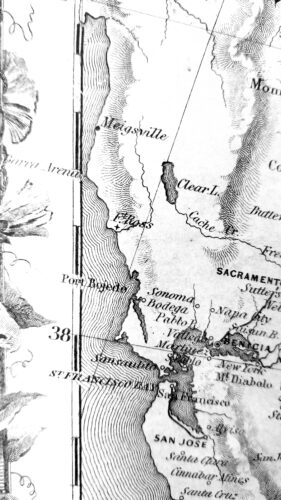
Working in the archives of the Kelley House Museum is fascinating because you are always finding tidbits of history that leave you going “Wow! I didn’t know that!” Like ghost towns . . . What?? We have ghost towns in our county? You bet we do.
Railroads gave us a lot of them. L.E. White’s lumber company railroad went out to a split in the tracks and they named it Salsig, or Manzanita. Now within Mendocino Redwood Lumber Company holdings, you could never get permission to go there, but it existed.
The north county had Andersonia near Bear Harbor, De Haven, Hardy Creek, Kibesillah, Kenny, Moody, Needle Rock, Union Landing, Usal and Wages Creek. Many were big enough to have a post office and a school and lasted as long as there were forests to cut.
Railroads went to, or by, Alpine (or Duffy), Christine, Glen Blair, Hopflat (eight miles up the Navarro River), Irmulco, Navarra (also spelled Navarro), Northwest (now Brooktrails), Sherwood and Salmon Creek.
Some ghost towns changed their names and survived. Willistville became Willits, Kendall City became Boonville, Sanel turned into Hopland, Miller became Bridgeport (though only one ranch is left). The folks at Cuffey’s Cove moved to Greenwood/Elk. Hermitage residents moved to Yorkville. Laguna became Cleone and Little Lake joined Willits.
“Honest” Harry Meiggs was in San Francisco in 1852 arranging financing for the Mendocino Lumber Company and met cartographers drawing maps of northern California. He pointed to Big River and said, “That’s Meiggsville!” Look at the map of the U.S.A. in the Escola Room of the Kelley House Museum and sure enough Mendocino City shows as Meigsville. This man later absconded with all the funding for the company and did NOT get the town named after him, except on one map.
If you lived in Coyote Valley your town is now under Lake Mendocino and if you lived in Hullsville your town is under Lake Pillsbury. If you lived in Melburne the word is still on a side of a barn on the Comptche-Ukiah Road. I always thought I’d like to live in Eden Valley and I’d expect it to be lovely. It’s southwest of Covelo.
Some towns could be transported on train cars. A kitchen, dining hall, school, store and sleeping cabins were all built to fit on flat cars. Once an area was logged the whole enterprise was put on rail cars and moved to the next work site. The Kelley House Museum in its archives has photos of these towns on rails being moved.
If you would like to take a look at these historic photos and maps — or volunteer as a researcher or writer — please contact curator@kelleyhousemuseum.org or call 707-937-5791.